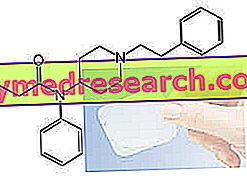Generality
Antipsychotic drugs - also known as neuroleptics - are drugs used to treat psychosis.

According to the DSM-IV classification (the diagnostic and statistical manual of mental disorders), psychotic disorders include:
- Schizophrenia;
- Schizophreniform disorder;
- Schizoaffective disorder;
- Delusional disorder;
- Short psychotic disorder;
- Shared psychotic disorder;
- Substance induced psychotic disorder (such as, for example, amphetamines, LSD, cocaine, etc.);
- Psychotic disorder due to general medical condition;
- Psychotic disorder not otherwise specified.
Generally, antipsychotics have a calming and antiallucinatory effect and stabilize mood in psychosis patients.
However, due to the side effects - even serious ones - that antipsychotics can induce, their use should be limited only to the treatment of very serious psychotic disorders, such as - for example - schizophrenia.
Schizophrenia
Schizophrenia is a psychiatric pathology that interferes with the individual's ability to communicate, to make judgments, to think coherently, to manage the emotional sphere and to distinguish what is real from what is not.
This pathology is characterized mainly by two types of symptoms:
- Productive (or positive) symptoms, these symptoms are associated with the common concept of madness and are delusions (of persecutory type, of greatness or of reading of thought), hallucinations (above all of auditory type, the so-called "voices"), disorders of thought and bizarre behavior;
- Negative symptoms, often confused with an intentional social withdrawal or with the voluntary lack of responsibility towards others. These symptoms include emotional flattening, loss of vital energy and poverty of both qualitative and quantitative thinking.
The causes of schizophrenia are not entirely clear but it seems that both environmental factors and a genetic component are involved.
In an attempt to explain the cause of the onset of this pathology, various neurochemical hypotheses have been formulated. Some of these hypotheses will be briefly illustrated below.
Dopaminergic hypothesis
According to this hypothesis, schizophrenia would be caused by an increase in dopamine signal or by hyperactivation of D2-like postsynaptic brain receptors.
This hypothesis is supported by the following facts:
- Levodopa (a drug used in the treatment of Parkinson's disease and a dopamine precursor) when given to schizophrenic patients aggravates the symptoms and - at the same time - can induce hallucinations in parkinsonian patients;
- Drugs that inhibit dopamine synthesis enhance the action of antipsychotics;
- High levels of dopamine have been identified in schizophrenic patients in certain brain areas and an increase in the number of D2 receptors in the limbic and striatum areas of the brain.
Glutamatergic hypothesis
According to this hypothesis, schizophrenia is caused by a glutamate deficiency, an amino acid having the role of an excitatory neurotransmitter in the central nervous system.
Serotoninergic hypothesis
According to this hypothesis, schizophrenia is caused by a serotonin deficiency. This theory is in agreement with the dopaminergic hypothesis. In fact, serotonin is a negative modulator of dopaminergic pathways and - its lack - can cause their hyperactivation.
The dopaminergic hypothesis - although it is not sufficient to explain the causes of schizophrenia - is certainly very credited, since practically all antipsychotics exert an antagonistic action on dopamine receptors.
However, with the arrival of the new antipsychotics (atypical antipsychotics) that also have affinities for other types of receptors - as well as for dopamine receptors - alternative hypotheses are being developed on the possible cause of schizophrenia.
Development of antipsychotics
The first antipsychotic drug - chlorpromazine - was synthesized in 1950 by chemist Paul Charpentier in an attempt to synthesize analogues of promethazine, a phenothiazine endowed with neuroleptic and antihistamine activity.
Later, the French surgeon Laborit and his collaborators discovered the ability of this drug to enhance the effects of anesthesia. They noted that chlorpromazine itself did not produce loss of consciousness, but favored a tendency to sleep and a marked disregard for the surrounding environment.
In 1952 the psychiatrists Delay and Deniker hypothesized that chlorpromazine was not only an agent capable of treating agitation and anxiety symptoms, but could also have a therapeutic effect in the treatment of psychoses.
From that moment on the development of the first class of antipsychotic drugs, phenothiazines began.
At the end of the 1950s another antipsychotic was synthesized, still widely used and belonging to the class of butyrophenones, haloperidol.
Haloperidol was discovered by chance by researcher Paul Janssen and his collaborators in an attempt to obtain similar drugs of meperidine (an opioid analgesic) with increased analgesic activity. The changes made to the meperidine molecule led to the development of an analogue which had increased analgesic activity, but which - at the same time - had antipsychotic effects similar to those of chlorpromazine.
Janssen and his collaborators understood that with appropriate structural changes in the molecule of the obtained analogue they could have eliminated the analgesic action in favor of neuroleptic activity. Following these modifications, haloperidol was finally obtained. This drug was marketed in Europe starting in 1958 and in the United States starting in 1967.
Antipsychotic drug classes
As stated above, the first class of antipsychotic drugs to be developed was that of phenothiazines, followed by the class of butyrophenones.
Later, research in this field continued and allowed the synthesis of new classes of drugs, up to the discovery of the most recent atypical antipsychotics.
phenothiazines
In reality, the term phenothiazine refers to a group of molecules that possess both antipsychotic and antihistamine activity. In this case, only phenothiazines with antipsychotic properties will be considered.
Phenothiazines with neuroleptic action are typical antipsychotic drugs that act by antagonizing D2 dopamine receptors. Chlorpromazine, perphenazine, thioridazine, fluphenazine, prochlorperazine, perphenazine and acetofenzain fall into this class.
The phenothiazines in addition to the neuroleptic properties, also boast anti-emetic properties (ie antivomito).
butyrophenones
Butyrophenones work by antagonizing dopamine D2 receptors and possess an affinity even against 5-HT2 receptors of serotonin. Butyrophenones also have anti-emetic properties in addition to antipsychotic ones.
Haloperidol, droperidol, trifluperidol and spiperone belong to this class.
Benzamide derivatives
To this category belongs sulpiride, an atypical antipsychotic drug. It works by antagonizing D2 dopamine receptors. Sulpiride - like all atypical antipsychotics - produces minor extrapyramidal side effects.
Benzazepine derivatives
The drugs belonging to this category are all atypical antipsychotics, therefore, they present a lower incidence of extrapyramidal side effects compared to typical antipsychotics.
They act by antagonizing the D2 receptors of dopamine and 5-HT2 of serotonin.
Clozapine, olanzapine, quetiapine and loxapine belong to this category of drugs.
Other atypical antipsychotics
Other atypical antipsychotics still used in therapy are risperidone and aripiprazole .
Side effects
The side effects induced by antipsychotics are due to the fact that these drugs - in addition to antagonizing dopamine and serotonin receptors - also exert an antagonistic effect on other receptor systems of the central nervous system, such as the adrenergic, histaminergic or cholinergic system.
Some of the side effects that antipsychotics can cause are:
- Sedation;
- Hypotension;
- Gastrointestinal disorders;
- Eye and vision disorders;
- Bladder disorders;
- Sexual dysfunctions.
Extrapyramidal effects are mainly caused by typical antipsychotics, while atypical antipsychotics have a lower incidence of these effects (but they are not entirely without them).
Extrapyramidal effects are also referred to as "Parkinson's-like effects" because they resemble the symptoms that occur in individuals with Parkinson's disease.
These effects are caused by the antagonism of antipsychotics against D2 dopamine receptors found in nigrostriatal areas of the brain.
Extrapyramidal symptoms include:
- Dystonia;
- Akathisia (inability to remain seated);
- Involuntary movements;
- bradykinesia;
- Muscle stiffness;
- Tremors;
- Shuffle.
Finally, antipsychotics can cause the onset of a particular disorder known as neuroleptic malignant syndrome. This syndrome is a neurological disorder characterized by:
- Temperature;
- Dehydration;
- Muscle stiffness;
- akinesia;
- Sweating;
- Tachycardia;
- Arrhythmia;
- Changes in the state of consciousness that can progress to stupor and coma.
If these symptoms appear, treatment with the drug should be stopped immediately and a doctor should be contacted immediately.



